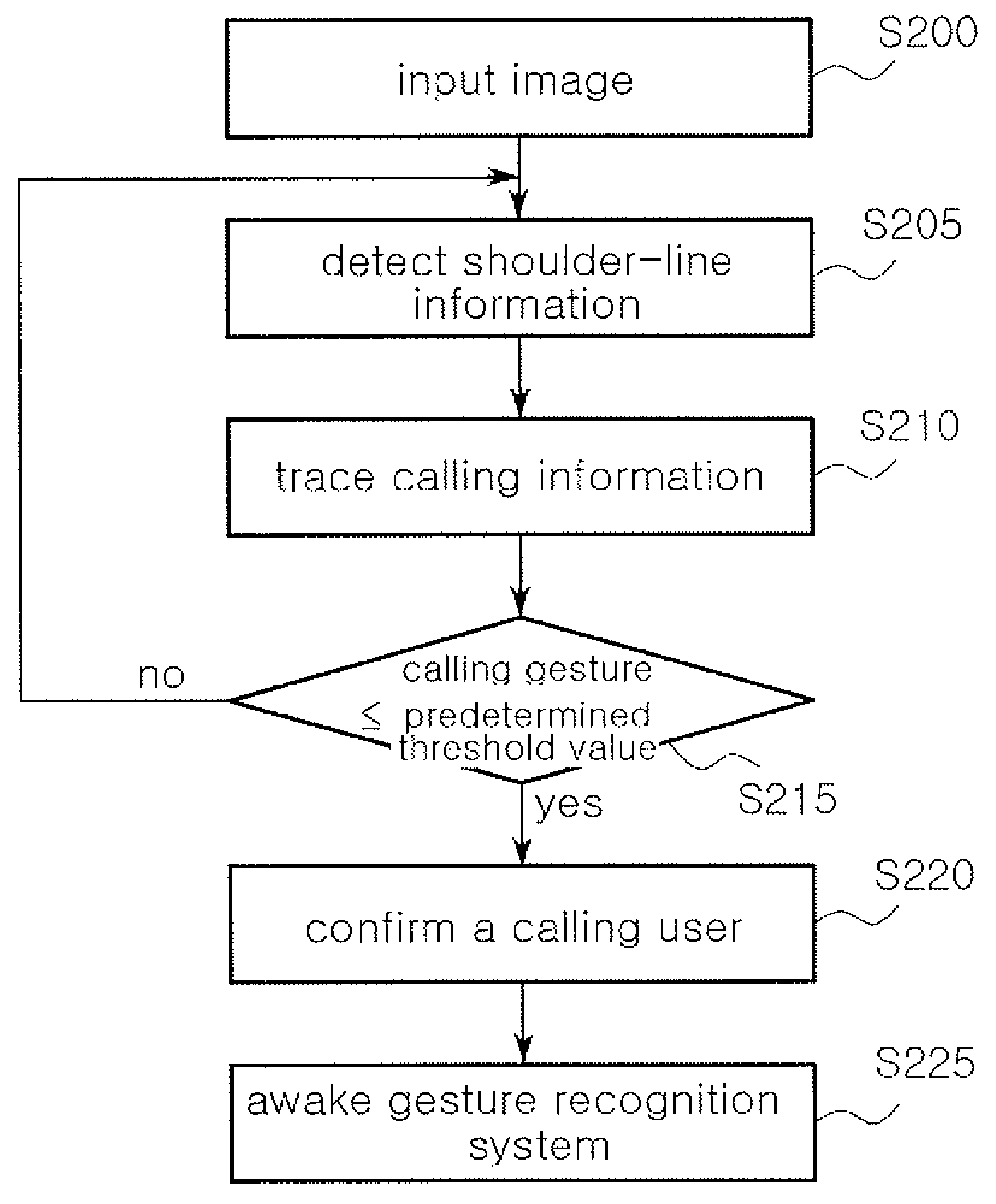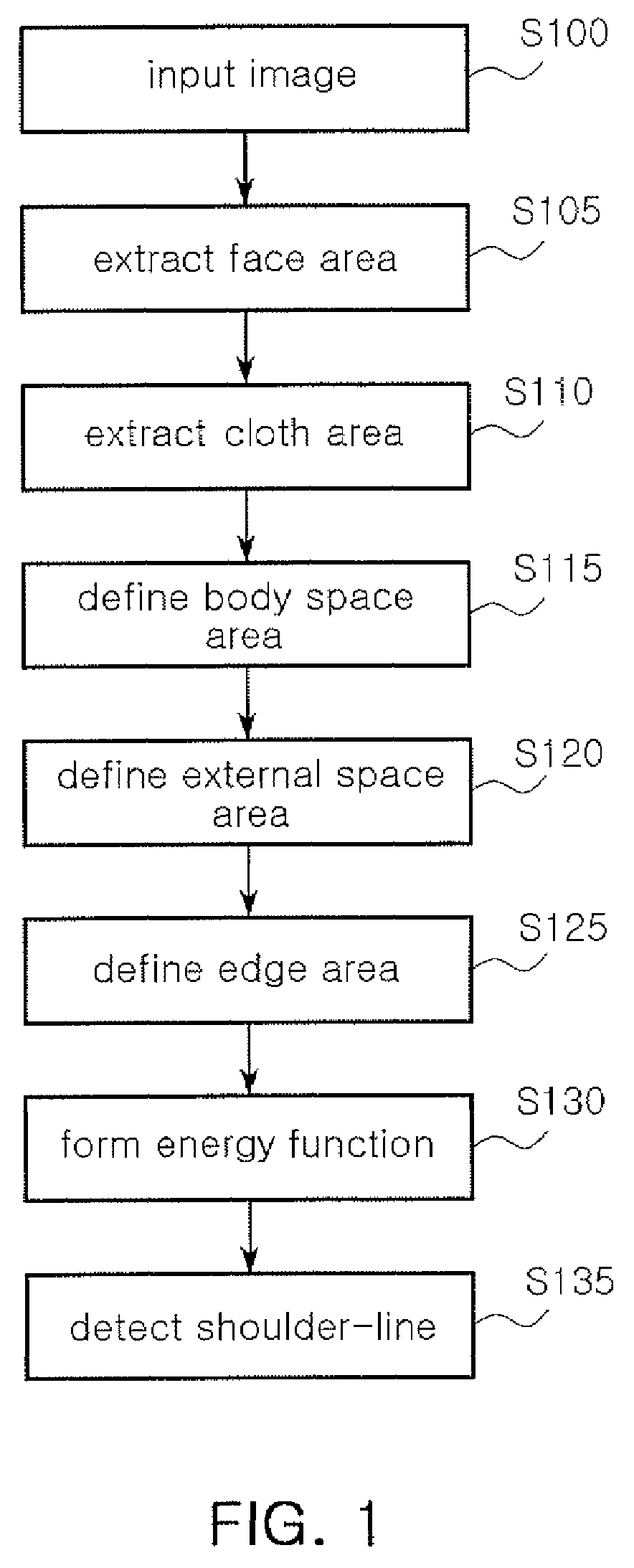Method and apparatus for shoulder-line detection and gesture spotting detection
a technology of gesture spotting and shoulderline detection, applied in the direction of instruments, static indicating devices, image data processing, etc., can solve the problem of difficult to efficiently make a command to the robo
- Summary
- Abstract
- Description
- Claims
- Application Information
AI Technical Summary
Benefits of technology
Problems solved by technology
Method used
Image
Examples
first embodiment
[0024]Hereinafter, a shoulder-line detecting method according to the present invention will be described in detail with reference to FIGS. 1 and 2.
[0025]FIG. 1 is a flowchart describing a method for detecting a shoulder-line in accordance with an embodiment of the present invention, and FIG. 2 is a view showing a relationship between a face area, a cloth area, and edge information which is defined through the shoulder-line detecting process.
[0026]Referring to FIG. 1, at step S100, an image of the object people is obtained and inputted to detect a shoulder-line of a target person. At steps S105 and S110, the face area and cloth area of the object people are extracted from the inputted image. This is to exclude unnecessary areas from being searched to detect the shoulder-line of the target person by separating a body space area and an external space area, which is an area out of the body, from the inputted image information. Arm motion candidate area information can be obtained based ...
third embodiment
[0041]Hereinafter, a shoulder-line detecting apparatus suggested according to the present invention will be described in detail with reference to FIG. 4. FIG. 4 is a block view showing a structure of a shoulder-line detecting apparatus in accordance with an embodiment of the present invention.
[0042]Referring to FIG. 4, the shoulder-line detecting apparatus 100 of the present embodiment of the invention includes an image input module 110, a body space area defining module 120, an external space area defining module 130, an edge area defining module 140, and a shoulder-line detecting module.
[0043]The image input module 110 receives a image of the object people from an image input device such as an external vision sensor.
[0044]The body space area defining module 120 extracts an area corresponding to the space of a human body from the image information transmitted from the image input module 110. For this, the body space area defining module 120 extracts a face area and a cloth area of ...
fourth embodiment
[0049]The suggested gesture spotting detection apparatus according to the present invention will be described with reference to FIG. 5, hereinafter. FIG. 5 is a block diagram describing a gesture spotting detection apparatus in accordance with an embodiment of the present invention.
[0050]Referring to FIG. 5, the gesture spotting detection apparatus includes an image input block 200, a shoulder-line detecting block 100, a calling gesture determining block 300, and a gesture recognition system calling block 400.
[0051]The image input block 200 receives a image of the object people from an image input device such as an external vision sensor.
[0052]The shoulder-line detecting block 100 extracts information on a shoulder-line of an object person based on the image information transmitted from the image input block 200. For this, the shoulder-line detecting block 100 includes a body space area defining module 120, an external space area defining module 130, an edge area defining module 140...
PUM
 Login to View More
Login to View More Abstract
Description
Claims
Application Information
 Login to View More
Login to View More - R&D
- Intellectual Property
- Life Sciences
- Materials
- Tech Scout
- Unparalleled Data Quality
- Higher Quality Content
- 60% Fewer Hallucinations
Browse by: Latest US Patents, China's latest patents, Technical Efficacy Thesaurus, Application Domain, Technology Topic, Popular Technical Reports.
© 2025 PatSnap. All rights reserved.Legal|Privacy policy|Modern Slavery Act Transparency Statement|Sitemap|About US| Contact US: help@patsnap.com



